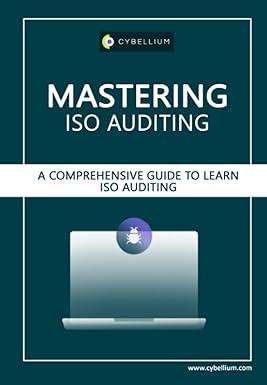Question
In April 1996 Sunbeam named Albert J. Dunlap as its CEO and chairman. Formerly with Scott Paper Co., Dunlap was known as a turnaround specialist
In April 1996 Sunbeam named Albert J. Dunlap as its CEO and chairman. Formerly with Scott Paper Co., Dunlap was known as a turnaround specialist and was even nicknamed Chainsaw Al because of the cost-cutting measures he typically employed. Almost immediately, Dunlap began replacing nearly all of the upper management team and led the company into an aggressive corporate restructuring that included the elimination of half of its 12,000 employees and the elimination of 87 percent of Sunbeams products. Unfortunately, in May 1998 Sunbeam disappointed investors with its announcement that it had earned a worse-than-expected loss of $44.6 million in the first quarter of 1998.1 CEO and Chairman Dunlap was fired in June 1998. In October 1998 Sunbeam announced that it would need to restate its financial statements for 1996, 1997, and 1998.
Beginning with the first quarter of 1997, Sunbeam began offering its customers discounts and other incentives if they placed their orders in the current period rather than holding off until the next period. Sunbeam did not disclose this practice of accelerating expected sales from later periods in its financial statements, however. In the other quarters of 1997, Sunbeam also allegedly relied on additional price discounting and other incentives in an attempt to accelerate recognition of revenue from future periods. One example of a special arrangement with a customer took place at the end of March 1997, just before the first quarter closed. Sunbeam recognized $1.5 million in revenue and contributed $400,000 toward net income from the sale of barbecue grills to a wholesaler. The contract with the wholesaler provided that the wholesaler could return all of the merchandise, with Sunbeam paying all costs of shipment and storage, if it was unable to sell it. In fact, the wholesaler wound up returning all of the grills to Sunbeam during the third quarter of 1997, and the wholesaler incurred no expenses in the transaction.
In December 1997 Sunbeam devised a distributor program that would help improve the companys sales. The program was designed to help Sunbeam accelerate the recognition of sales revenue for merchandise it placed with distributors in advance of actual retail demand. Sunbeam allegedly used favorable payment terms, discounts, guaranteed markups, and, consistently, the right to return unsold product as incentives for distributors to participate in the program. The sales under the distributor program represented a new distribution channel for the company. Therefore Sunbeam was unable to set an appropriate level of reserves for any returns.
In the second quarter of 1997 Sunbeam recognized $14 million in sales revenue from bill and hold sales. By the fourth quarter Sunbeam had recognized $29 million in revenues and contributed an additional $4.5 million toward net income in bill and hold sales after it began promoting its bill and hold program. In all, bill and hold sales contributed to 10 percent of the fourth quarters revenue. At year-end 1997, Sunbeam disclosed in its annual filing to the SEC that the amount of [the] bill and hold sales at December 29, 1997, was approximately 3 percent of consolidated revenues. It did not disclose the extent to which the bill and hold sales had been booked in the final quarter.
Questions:
1. Consider the principles, assumptions, and constraints of Generally Accepted Accounting Principles (GAAP). What revenue recognition issues are at hand for Sunbeam with regard to the three sales situations detailed for March 1997, December 1997 and the 2nd quarter of 1997.
2. What authoritative guidance is relevant for determining the appropriate accounting in each of the circumstances presented.
3. For each issue, determine if Sunbeam's accounting treatment was appropriate or not. Provide a detailed rationale based upon the authoritative guidance cited in 2 above.
4. What recommendations do you have for the Board
Step by Step Solution
There are 3 Steps involved in it
Step: 1

Get Instant Access to Expert-Tailored Solutions
See step-by-step solutions with expert insights and AI powered tools for academic success
Step: 2

Step: 3

Ace Your Homework with AI
Get the answers you need in no time with our AI-driven, step-by-step assistance
Get Started


